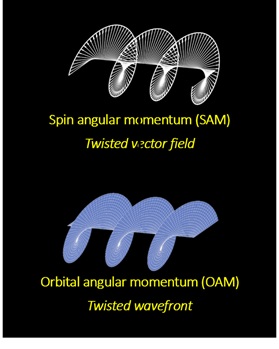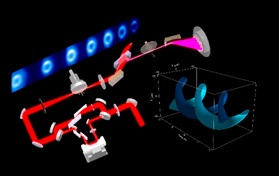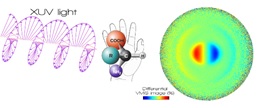Comme toute particule massive, les photons peuvent être porteurs d’un spin et d’un moment angulaire orbital. Le premier est associé à la polarisation circulaire d’un faisceau lumineux, tandis que le second est associé à un front d’onde hélicoïdal (voir par exemple la revue de A. M. Yao et M. J. Padgett).
Ces deux types de faisceaux trouvent des applications dans des situations différentes. En particulier, alors que la projection du spin le long de l’axe de propagation pour les faisceaux paraxiaux est limitée à deux valeurs, ![]()
Le moment angulaire orbital peut prendre n’importe quelle valeur entière positive ou négative. Au LIDYL, nous étudions le transfert de ces propriétés d’un laser IR de commande au faisceau attoseconde XUV.

Transfert du moment angulaire orbital
Les faisceaux gaussiens de Laguerre constituent une base pour les faisceaux lumineux présentant un moment angulaire orbital (voir par exemple la présentation deD. Dounas-Frazer). Cela permet un encodage beaucoup plus dense des informations sur les faisceaux lumineux. Pour les perspectives spectroscopiques et d’imagerie en particulier, il serait inestimable d’avoir à portée de main des faisceaux XUV porteurs de moment angulaire orbital. C’est également une situation idéale pour tester les lois de conservation dérivées de la mécanique quantique.
Nous avons réussi à transférer le moment angulaire orbital d’un faisceau de lumière visible vers l’XUV en utilisant le processus de génération de hautes harmoniques. Ces faisceaux ont un front d’onde hélicoïdal associé à une phase azimutale. La singularité de phase au centre du faisceau conduit à une intensité nulle, ce qui explique leur forme de « beignet ». C’est ce que montre la figure de gauche. Nous pourrions également mesurer leur « charge topologique » et vérifier la loi de conservation : l’harmonique q transporte q fois le moment angulaire orbital du laser de commande. Enfin, nous avons pu mesurer leur structure spatio-temporelle, qui présente un motif en double hélice.

Grâce à une collaboration avec le groupe de Giovanni de Ninno, nous avons pu généraliser cette loi de transfert au cas des HHG à deux faisceaux.
Financement : ANR Xstase coordonné par Thierry Ruchon
Personnes : Antoine Camper, Romain Géneaux, Céline Chappuis, Thierry Auguste, Thierry Ruchon
Publications :
Géneaux R et al, « Synthesis and characterization of attosecond light vortices in the extreme ultraviolet« , Nature Communications, Vol. 7, pp. 12583 (2016).
Gauthier D et al, « Tunable orbital angular momentum in high-harmonic generation« , Nature Communications Vol. 8, 14971 (2017).
Voir aussi le communiqué de presse sur le site du CEA Géneaux et al.
Transfert de spin Moment angulaire
Les molécules chirales, qui sont des molécules non superposables à leur image miroir (comme les mains par exemple), sont omniprésentes dans la nature. La chiralité est même parfois proposée comme une condition de l’émergence de la vie. D’un point de vue plus pratique, les deux formes d’un produit chimique chiral interagissent généralement de manière très différente avec les organismes vivants. L’étude de la dynamique des molécules chirales présente donc un intérêt à la fois fondamental et appliqué.
Cependant, nous connaissons très mal leur dynamique à l’échelle de temps de la femtoseconde et en dessous, ce qui est dû à un manque d’outils de diagnostic adaptés. Dans une série de travaux coordonnés par Yann Mairesse et Valérie Blanchet au CELIA-Bordeaux, nous avons montré comment une source HHG accordée pouvait fournir la sonde parfaite pour ces molécules, avec une résolution temporelle femtoseconde à attoseconde. Plus précisément, en accordant l’état de polarisation du laser de commande, nous avons réussi à générer des harmoniques à polarisation quasi circulaire.
Nous les avons utilisées pour mesurer le dichroïsme circulaire des photoélectrons (PECD) dans un spectromètre d’imagerie à carte de vitesse. Ce phénomène, limité aux objets chiraux et dépendant de leur chiralité, a été largement étudié sur des sources synchrotron quasi continues (Desirs com.). Cette première étude a été étendue à tous les régimes de photoionisation (multiphotonique, tunnel, directe), montrant l’universalité du phénomène. Plus récemment, grâce à des expériences de type RABBIT, nous avons pu mesurer un léger délai, de l’ordre de 7 secondes, entre les électrons sortant d’une molécule chirale d’un côté ou de l’autre.

Cette recherche a été réalisée au CELIA-Bordeaux, en collaboration avec l’équipe de la ligne de faisceau DESIRS sur le synchrotron SOLEIL et le laboratoire LCAR à Toulouse.
Voir aussi le communiqué de presse sur le site du CNRS Ferré et al.
Financement côté LIDYL : ANR Xstase coordonné par Thierry Ruchon
Personnes du LIDYL : Romain Géneaux, Céline Chappuis, Thierry Ruchon
Publications :
« A table-top ultrashort light source in the extreme ultraviolet for circular dichroism experiments«
Ferré A et al, Nat Photon, Vol. 9(2), pp. 93-98. (2015).
« Probing ultrafast dynamics of chiral molecules using time-resolved photoelectron circular dichroism«
Beaulieu S, et al, Faraday Discuss. Vol. 194, pp. 325. (2016).
« Photoionisation de molécules chirales résolue à l’attoseconde«
Beaulieu S, et al, Science, Vol. 358(6368), pp. 1288, (2017).


